Aquarists often admire the lip-locking behavior of kissing gouramis (Helostoma temminckii).
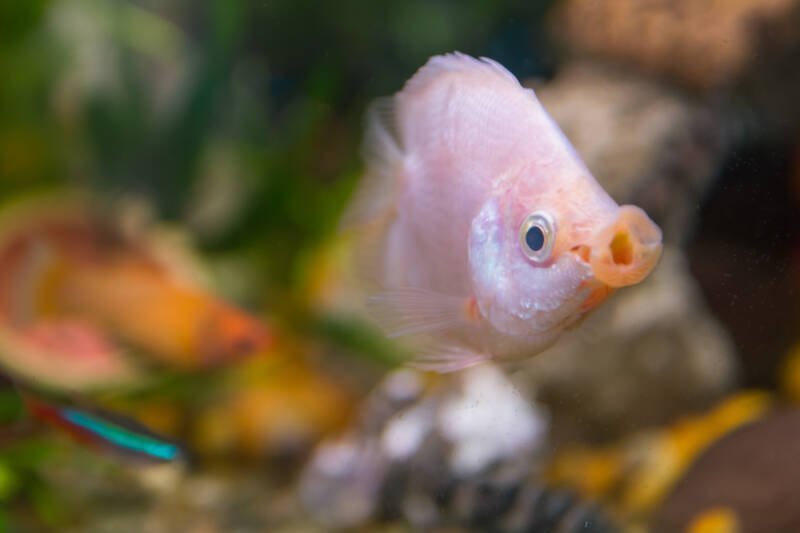
Often misinterpreted by the general public as a sign of affection, the dominance display demonstrates this member of the gourami group’s unique mouth anatomy.
The only member of the Helostomatidae family, kisser fish have an extra joint in their jaws.
The addition increases the angle the mouth can stretch, allowing them to reach and take in more food. It also gives them a permanent pout – one of the more attractive features about them.
As hardy as most gouramis, kissers only present a few challenges for their admirers.
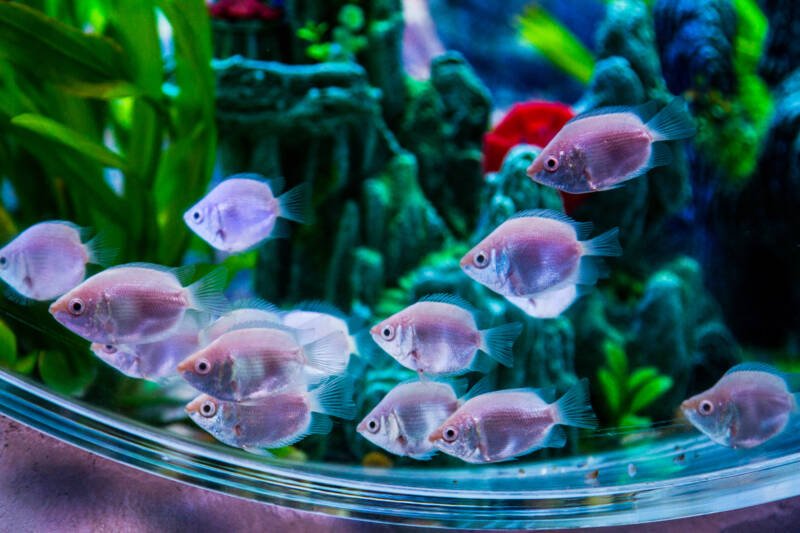
However, unless prepared to handle their adult size, novice aquarists might want to skip the kissing gourami. When it comes to management, that tank size presents some challenges.
At a Glance
| Tank Size: | 50 gallons (189 l) MINIMUM |
| School Size: | alone or in male/female pair |
| Temperature: | 72-82°F (22-28°C) |
| Lifespan: | 5-7 years |
| Size: | 6.0 inches (15 cm) |
| pH: | 6.8-8.5 |
| Hardness: | 5-20 dH |
| Ammonia: | 0 ppm |
| Nitrite: | 0 ppm |
| Nitrate: | <10 ppm |
In this article
In the Wild
Kissing gouramis frequent slow-moving waters in Borneo, Cambodia, Indonesia, Malaysia, Thailand, and Vietnam.
Courtesy of their labyrinth organ, they’re every bit as happy in marshy conditions as they are floodplains. Calm waters with heavy plantings keep kissers happiest.
The abundance of dissolved minerals creates blackwater conditions, and you’ll find kissers in waters as acidic as 3.0-4.0!
Conditions fluctuate through the wet and dry seasons, though, and they tolerate the changes well.
In the southern Indochina region, you’ll find cultivated kissing gouramis. Of course, those fish are raised for food, NOT aquariums.
Kissers represent a valuable food culture for the region, and you’ll often find gouramis on local menus.
Appearance
The wild mottled or piebald kissing gourami sports greyish-green scales with dark fins and a black vertical bar at the base of the caudal fin.
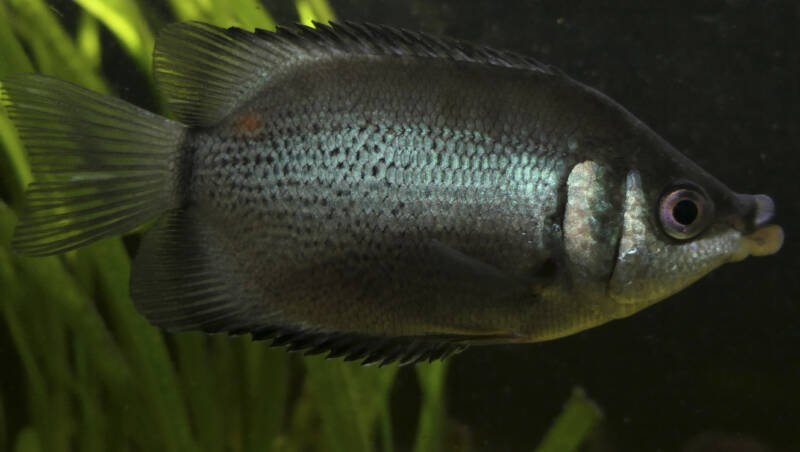
You’ll also get occasional dark horizontal stripes for a nice change.

Mottled kissers are plainer than the mutated green or pink version most aquarists prefer (kind of expected for wild freshwater fish).
In addition to the natural color occurring in the wild, you may stumble upon three other options in the fish store.
The pink kisser – the most popular version with aquarists – does not occur in nature.
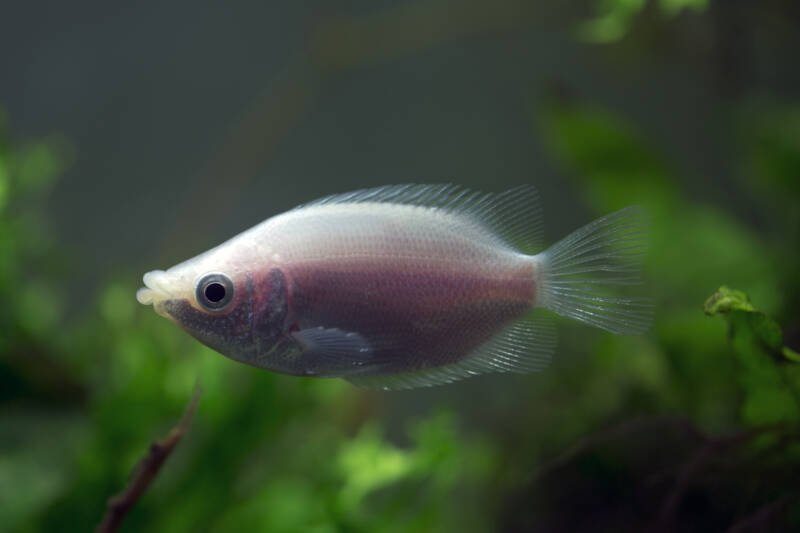
The balloon pink kisser is a “dwarf gourami” fashionable version of the pink kisser. Unfortunately, this mutated option isn’t very hardy and has a shorter lifespan.

Size: Larger Than Expected
In their native habitat, kissing gouramis grow to an impressive length of 12 inches (30 cm)!
Is it any wonder people keep them on farms as a food source? However, aquarists rarely see their kissers achieve this length in captivity.
Restricted by modest tank sizes, you should expect a maximum length of around 6 inches (15 cm) for your kissing gouramis.

The confined living space cuts down on their size. But if you want to see your fish expand, reach for the largest aquarium possible – and DON’T crowd it.
Lifespan
On average, when kept under proper conditions (and healthy tank size), kisser fish survive between 5-7 years.
However, aquarists have recorded some of their fish living a stunning 25 years! If you’re up to the task of pristine living conditions, you might match that record.
Behavior
Kissing gouramis have a semi-aggressive nature, and it gets worse when aquarists house them together.
You can safely keep a male and female together without too much trouble, but if you set your sights on larger schools, you could find yourself running into problems.
Kisser fish earned their name from their “kissing” behavior. Two males (most of the time) press their mouths together to challenge each other over territory.
As they age and decide which parts of the tank belong to who, the behavior diminishes. But getting to that point’s tricky.
You also need to keep the breathing habits of your kissers in mind.
Gouramis – and other labyrinth fish, such as bettas – have poorly-developed gills.
They need to swim to the surface to take in oxygen. It’s a natural part of their behavior you expect to see.
However, TOO much time spent at the surface is a warning!
Gouramis constantly gulping air should tip you off that your tank’s health has slipped. You need to check your tank’s water quality to make sure conditions haven’t changed.
Tank Setup
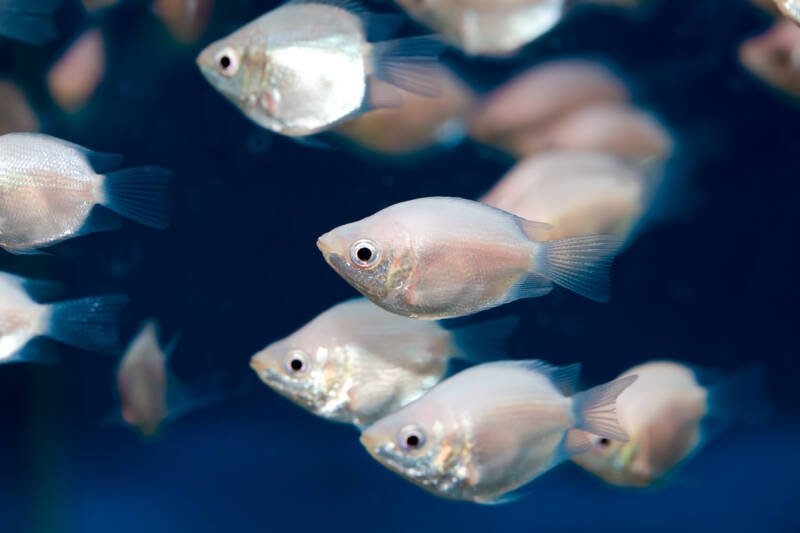
For a pair of kissing gouramis, the minimum tank size is 50 gallons (189 l).
However, if you want to maximize their health and swimming space, consider aiming for a 75-gallon (284 l) aquarium. And for each kisser you add, increase the tank by 30 gallons (114 l).
You want to find a sturdy lid for the top of your aquarium. Kissers don’t jump, but they make visits to the surface to breathe.
A tight-fitting cover keeps the pocket of air warm and humid. If your fish breathe cold air, it will damage their labyrinth organ.
Kisser fish don’t require air stones to provide additional oxygen sources.
And they prefer minimal water currents, so keep the flow turned down on your filters. If they’re hanging out at the surface too much, look at your water quality for the problem.
Water Conditions
Kissing gouramis want to stick to the tropical waters of their native regions. Invest in a quality heater so you can keep the water around 72-82°F (22-28°C).
The air at the surface doesn’t need to be a specific temperature, so long as it stays warmer than the surrounding room.
In the wild, kissers adapt to changing waters as the monsoons move through. They cope with blackwater conditions and low acidities.
You should try for a neutral pH. However, they’ll tolerate anything within a ph range of 6.8-8.5.
You have some flexibility in water hardness (5-20 dH), but try to keep your water conditions as stable as possible. Kisser fish DON’T tolerate ammonia, nitrites, or nitrates well.
If you practice pristine water quality from the start, you’ll see a healthier outcome for your fish.
Decorating the Kissing Gourami Tank
The tiny rows of teeth within their jointed mouths allow kissing gouramis to scrape algae from aquarium surfaces.
As such, they appreciate large-grained gravel and river rocks along the bottom of the tank. Gravel also keeps your kissers from burrowing too deep into the substrate.
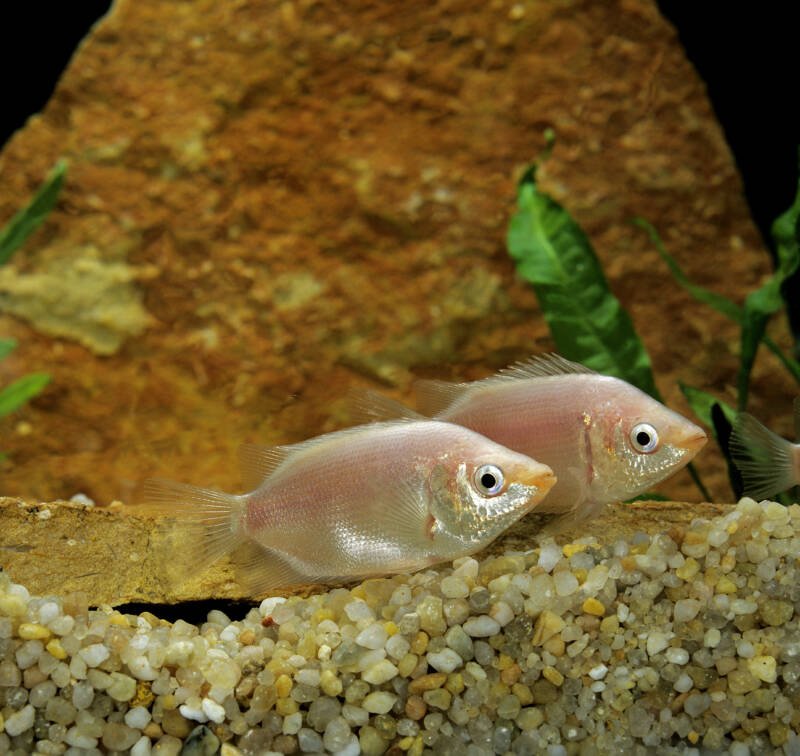
As you might guess (since they devour algae), kisser fish fall into the omnivore category. And they can DECIMATE plants in an aquarium.
Some aquarists avoid this problem by filling their tanks with plastic plants, but you don’t have to go to that extreme. Thick vegetation cover helps kissing gouramis feel protected and content.
And if you choose hardy, durable plants, they’ll survive exploratory snacking by your kissers.
Some of the best options of plants for kisser tanks include:
- Hornwort
- Java fern
- Java moss.
Always make sure you leave the surface of the tank open. Remember, your kissing gouramis need room to go up and breathe.
If there are too many floating plants, they’ll end up struggling, and their health will suffer.
Kissing Gouramis in Communities
Due to their semi-aggressive nature, kissing gouramis need careful consideration before they can integrate into a community.
You also want to consider how large of an aquarium you want to support. Don’t sacrifice space simply to have a colorful tank.
Tank Mates
Kisser fish do best with fish their approximate size. Choose species known to have a hardy reputation. After all, they’re going to have to hold up to some potential bullying. Ideal tank mates include:
- Angelfish
- Archerfish
- Chinese algae eater
- Small cichlids
- Clown loach
- Congo tetra
- Pictus catfish
- Rosy barb
- Yoyo loach
While most medium-sized fish work well with kissing gouramis, you still want to keep an eye on things.
Kissers WILL ram their jointed mouths against the side of another fish and strip away the protective slime coat. The victim may then succumb to infection. Prepare to intervene.
Incompatible Species
You should AVOID pairing kissers with any other gouramis – or fish that resemble gouramis.
They turn aggressive toward fish with the same appearance, and they’ll attempt to engage in their territorial display. (Which doesn’t work for the other fish)
Smaller fish – such as guppies, mollies, rasboras – need to stay out of community tanks. Kissing gouramis often snatch them up as snacks. After all, the extra joint in their mouths allows for enhanced mouth mobility. You’re better off skipping the risk.
The same goes for the other end of the spectrum: avoid larger fish. Kissers might have some bluster, but it won’t hold up against bigger bullies in the pond.
The larger members of the cichlid family will see your kisser fish as a quick snack.
Finally, skip adding invertebrates to your community aquarium. Kissing gouramis are opportunistic feeders. They won’t hesitate to attempt to feed on your freshwater shrimp or snails. And, again, their mouths are designed to help with the process.
Food and Diet
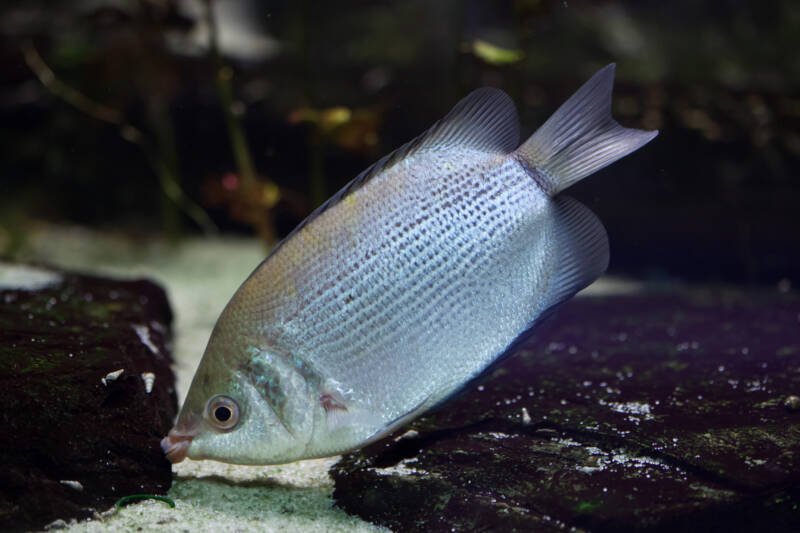
As omnivores, kissing gouramis view the entire menu with interest.
They also have a couple of exciting adaptations to help them savor a little bit of everything.
First is the extra mouth joint. Second are gill rakers that help them strain plankton from the water.
However, while your kisser fish can scrape algae from the tank’s surfaces and pull microscopic plankton from the water, that doesn’t mean you’re off the hook.
You still need to do your part to keep your fish as healthy as possible. Look for commercial foods with a significant portion of spirulina.
And then make sure you supplement them with a quality protein source. You can choose from live, frozen, or freeze-dried options.
Kisser favorites include:
- Bloodworms
- Brine shrimp
- Daphnia
- Tubifex worms.
And to protect your tank plants, you can add in healthy vegetables. However, the adaptation of kisser fish’s mouths prevents them from chewing or swallowing large pieces.
Make sure you chop these veggies into suitably small pieces before you put them into the tank:
- Carrots
- Lettuce
- Peas
- Spinach
- Zucchini.
Breeding Your Kissing Gouramis: Scatter-Layers
Many labyrinth fish produce bubble nests. Kissing gouramis break the tradition and scatter their eggs across the surface of the water.
This doesn’t make them difficult to breed, but there are still a few challenges you’ll need to overcome to produce kisser fry.
Male or Female?
Unfortunately, determining whether you have a male or female kissing gourami is almost impossible. The two sexes look identical. They have the same coloration, the same fins, and the same shape.
Until the female rounds out with eggs, there’s no telling them apart. (Sorry)
Careful Conditioning
To increase your odds of success, set up a separate breeding tank for your kisser pair.
Ensure the tank is clean and float a lettuce leaf at the top. The leaf will help collect most of the eggs and create a site for infusoria to feed the fry.
You want to condition your pair for several weeks first. Slowly increase the amount of live food you incorporate into their diet. And make sure you’re using high-quality ingredients.
Doing this will signal that there’s plenty of resources to start producing eggs.
Set the water temperature in the tank to the higher end of the kisser fish preference, around 80-82°F (26.6-27.7°C).
This mimics the temperature in their native waters during spawning season, which happens between May and October.
Spawning ritual
The male and female will begin swimming around in circles. Then they’ll start to nudge each other in a “dance.”
Eventually, you’ll see them rapidly beating their tails back and forth.
Eggs and Fry
The male flips the female upside down, and she lays the eggs. He fertilizes them as they float up.
Remove the pair once the eggs get laid. If you don’t, they’ll cannibalize the fry.
Eggs hatch after a day. The fry can feed on the infusoria within the tank. After two days, they become free-swimming, and you can graduate them to freshly-hatched brine shrimp.
Health and Diseases
Kissing gouramis rank as a hardy fish species available to aquarists.
If you choose an appropriately-sized tank, provide a varied and high-quality diet, and maintain pristine water conditions, you shouldn’t see any problems.
However, if maintenance slides, their immune systems can start to break down. And then you may see signs of one of the following:
- Hole in the Head: A protozoan parasite creates small pits in the skin. The openings then allow bacteria to invade. Untreated, infection can spread FAST.
- Ich: The ectoparasite’s typical white spots aren’t always easy to spot on the pink form of kisser fish. Always quarantine any new arrivals.
- Parasitic Algae: Kissing gourami can house the algae as spots under the skin. It’s not life-threatening, but the host fish ends up weaker than others in the tank.
The Famous Kissing Fish: Are They for You?
Aquarists and the general public have been fascinated with kissing gouramis for years.
The unique adaptation of their mouths – and their territorial displays – continue to enchant people. And if you’re ready to handle their tank size needs, they make great additions.
Considering the size they reach, kissing gouramis have a reasonable cost of around $5.
A pair won’t set you back much – though you need to keep the aquarium’s price in the back of your mind. However, the unique qualities of these gouramis are worth it.
Have you wrangled kissing gouramis? How often did you witness territorial wrestling?
Which varieties have you kept?
Share your stories and questions with us here!